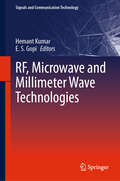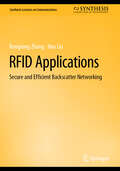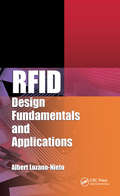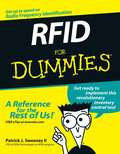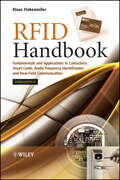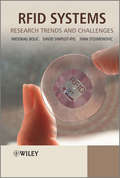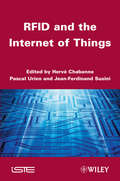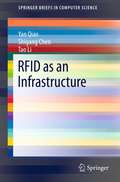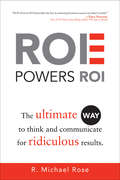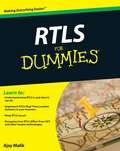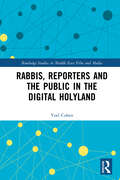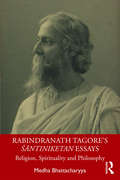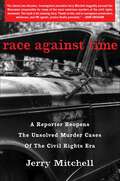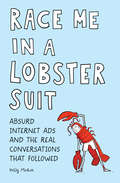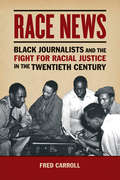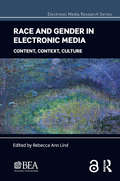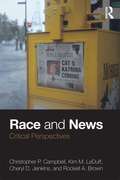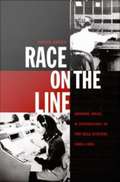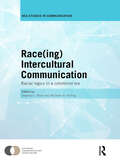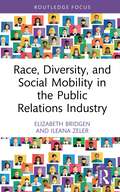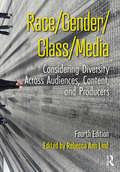- Table View
- List View
RF, Microwave and Millimeter Wave Technologies (Signals and Communication Technology)
by E. S. Gopi Hemant KumarThis book provides in-depth exposure to emerging technologies and recent advancements in RF, Microwave, and Millimetre Wave Technologies. The book covers the basic concepts along with the recent advancements in designing and developing antennas and circuits for the latest technologies. The concepts of mode compression, Full Duplex communication, massive MIMO, frequency selective surfaces, reflectarrays, and metasurfaces have been discussed in detail. Various types of antennas, such as electrically small antennas, textile antennas, dielectric resonator antennas, etc., to be used for the latest wireless devices, RFID applications are also thoroughly explored. The concept of machine learning to develop data-driven models for antenna design is also discussed briefly to provide readers with an introduction to the ML algorithms. The readers will be able to understand the theoretical concepts and practical design aspects of various antennas, high-frequency circuits, and device modeling. The target audience includes but is not limited to undergraduates, post-graduates, research scholars, academicians, scientists, and professionals who are interested in getting the latest knowledge in the field of RF, Microwave, and Millimetre Wave Technologies.
RFID Applications: Secure and Efficient Backscatter Networking (Synthesis Lectures on Communications)
by Hao Liu Rongrong ZhangThis book introduces current efficient and secure backscatter networking schemes for RFID. The authors integrate these schemes with a concrete example, namely RFID-based missing item detection. The book presents a large palette of tools indispensable in the RFID-based passive IoT (such as compute complexity analysis, approximate algorithm design, the probabilistic data structure, and the protocol stack in COTS and software-defined RFID tags) and how these tools can be carefully tuned and adapted to be practically applied in RFID systems. The book elaborates the state-of-the-art research bringing the conventional data structure and traffic engineering technology in the core network into the emerging IoT applications of RFID. This does not only boost the performance for RFID systems, but also inspires new research directions. The authors believe that this book will interest researchers, professionals, and graduates working in RFID system design and engineering, low-power IoT as well as other related fields.
RFID Design Fundamentals and Applications
by Albert Lozano-NietoRFID is an increasingly pervasive tool that is now used in a wide range of fields. It is employed to substantiate adherence to food preservation and safety standards, combat the circulation of counterfeit pharmaceuticals, and verify authenticity and history of critical parts used in aircraft and other machinery—and these are just a few of its uses. Goes beyond deployment, focusing on exactly how RFID actually works RFID Design Fundamentals and Applications systematically explores the fundamental principles involved in the design and characterization of RFID technologies. The RFID market is exploding. With new and enhanced applications becoming increasingly integral to government and industrial chain supply and logistics around the globe, professionals must be proficient in the evaluation and deployment of these systems. Although manufacturers provide complete and extensive documentation of each individual RFID component, it can be difficult to synthesize and apply this complex information—and users often must consult and integrate data from several producers for different components. This book covers topics including: Types of antennas used in transponders Components of the transponder, memory structure and logic circuits Antennae for RFID interrogators Types of modulation Organization and characteristics of commercial transponders Communication links Modes of operation for transponders operating at different frequencies Principles of arbitration and anti-collision Commands used by transponders This powerful reference helps to resolve this dilemma by compiling a systematic overview of the different parts that make up the whole RFID system, helping the reader develop a clear and understanding of its mechanisms and how the technology actually works. Most books on RFID focus on commercial use and deployment of the technology, but this volume takes a different and extremely useful approach. Directed toward both professionals and students in electronics, telecommunications, and new technologies, it fills the informational void left by other books, illustrating specific examples of available semiconductors and integrated circuits to clearly explain how RFID systems are configured, how they work, and how different system components interact with each other.
RFID For Dummies
by Ii Patrick J. SweeneyMany companies have asked suppliers to begin using RFID (radio frequency identification) tags by 2006 RFID allows pallets and products to be scanned at a greater distance and with less effort than barcode scanning, offering superior supply-chain management efficiencies This unique plain-English resource explains RFID and shows CIOs, warehouse managers, and supply-chain managers how to implement RFID tagging in products and deploy RFID scanning at a warehouse or distribution center Covers the business case for RFID, pilot programs, timelines and strategies for site assessments and deployments, testing guidelines, privacy and regulatory issues, and more
RFID Handbook
by Klaus Finkenzeller Dörte MüllerThis is the third revised edition of the established and trusted RFID Handbook; the most comprehensive introduction to radio frequency identification (RFID) available.This essential new edition contains information on electronic product code (EPC) and the EPC global network, and explains near-field communication (NFC) in depth. It includes revisions on chapters devoted to the physical principles of RFID systems and microprocessors, and supplies up-to-date details on relevant standards and regulations.Taking into account critical modern concerns, this handbook provides the latest information on:the use of RFID in ticketing and electronic passports; the security of RFID systems, explaining attacks on RFID systems and other security matters, such as transponder emulation and cloning, defence using cryptographic methods, and electronic article surveillance; frequency ranges and radio licensing regulations. The text explores schematic circuits of simple transponders and readers, and includes new material on active and passive transponders, ISO/IEC 18000 family, ISO/IEC 15691 and 15692. It also describes the technical limits of RFID systems.A unique resource offering a complete overview of the large and varied world of RFID, Klaus Finkenzeller's volume is useful for end-users of the technology as well as practitioners in auto ID and IT designers of RFID products. Computer and electronics engineers in security system development, microchip designers, and materials handling specialists benefit from this book, as do automation, industrial and transport engineers. Clear and thorough explanations also make this an excellent introduction to the topic for graduate level students in electronics and industrial engineering design.Klaus Finkenzeller was awarded the Fraunhofer-Smart Card Prize 2008 for the second edition of this publication, which was celebrated for being an outstanding contribution to the smart card field.
RFID Systems
by Ivan Stojmenovic Miodrag Bolic David Simplot-RylThis book provides an insight into the 'hot' field of Radio Frequency Identification (RFID) SystemsIn this book, the authors provide an insight into the field of RFID systems with an emphasis on networking aspects and research challenges related to passive Ultra High Frequency (UHF) RFID systems. The book reviews various algorithms, protocols and design solutions that have been developed within the area, including most recent advances. In addition, authors cover a wide range of recognized problems in RFID industry, striking a balance between theoretical and practical coverage. Limitations of the technology and state-of-the-art solutions are identified and new research opportunities are addressed. Finally, the book is authored by experts and respected researchers in the field and every chapter is peer reviewed.Key Features:Provides the most comprehensive analysis of networking aspects of RFID systems, including tag identification protocols and reader anti-collision algorithms Covers in detail major research problems of passive UHF systems such as improving reading accuracy, reading range and throughput Analyzes other "hot topics" including localization of passive RFID tags, energy harvesting, simulator and emulator design, security and privacy Discusses design of tag antennas, tag and reader circuits for passive UHF RFID systems Presents EPCGlobal architecture framework, middleware and protocols Includes an accompanying website with PowerPoint slides and solutions to the problems http://www.site.uottawa.ca/~mbolic/RFIDBook/This book will be an invaluable guide for researchers and graduate students in electrical engineering and computer science, and researchers and developers in telecommunication industry.
RFID and the Internet of Things
by Jean-Ferdinand Susini Pascal Urien Hervé ChabanneRFID (Radio Frequency Identification) technology allows for automatic identification of information contained in a tag by scanning and interrogation using radio frequency (RF) waves. An RFID tag contains an antenna and a microchip that allows it to transmit and receive. This technology is a possible alternative to the use of barcodes, which are frequently inadequate in the face of rapid growth in the scale and complexity of just-in-time inventory requirements, regional and international trade, and emerging new methods of trade based on it. Use of RFID tags will likely eventually become as widespread as barcodes today. This book describes the technologies used for implementation of RFID: from hardware, communication protocols, cryptography, to applications (including electronic product codes, or EPC) and middleware. The five parts of this book will provide the reader with a detailed description of all the elements that make up a RFID system today, including hot topics such as the privacy concerns, and the Internet of Things.
RFID as an Infrastructure
by Yan Qiao Tao Li Shigang ChenRFID (radio frequency identification) tags are becoming ubiquitously available in object tracking, access control, and toll payment. The current application model treats tags simply as ID carriers and deals with each tag individually for the purpose of identifying the object that the tag is attached to. The uniqueness of RFID as an Infrastructure is to change the traditional individual view to a collective view that treats universally-deployed tags as a new infrastructure, a new wireless platform on which novel applications can be developed. The book begins with an introduction to the problems of tag estimation and information collection from RFID systems, and explains the challenges. It discusses how to efficiently estimate the number of tags in a large RFID system, considering both energy cost and execution time. It then gives a detailed account on how to collect information from a sensor-augmented RFID network with new designs that significantly reduce execution time.
RISK!: True Stories People Never Thought They'd Dare to Share (The\wiley Series In Personality Disorders Ser. #2)
by Kevin AllisonA diverse collection of uncensored, confessional, and at times outrageously funny essays about coming of age, coming out, and the wildest experiences that define us.Collecting the most celebrated stories from the hit podcast RISK!, along with all-new true tales about explosive secrets and off-the-wall adventures, this book paints a spellbinding portrait of the transformational moments we experience in life but rarely talk about. No topics are off-limits in RISK!, no memories too revealing to share. From accidentally harboring a teen fugitive to being poisoned while tripping on LSD in the Mayan ruins, these stories transport readers into uncharted territory and show how your life can change when you take an extraordinary leap. In these jaw-dropping stories, edited and introduced by RISK! host Kevin Allison, writers reveal how they pushed drugs for a Mexican cartel only to end up kidnapped and nearly killed, how they joined a terrifying male-empowerment cult and fought desperately for a way out, how they struggled with pregnancy complications and found a hero where they least expected it, and so much more. A lifelong construction worker shares the intimate details of transitioning to being a woman, a bestselling author discusses how he assumed the identity of his babysitter online in a social experiment gone awry, and a beloved comedian discusses how a blow job from a prostitute changed his life. By turns cautionary and inspiring, RISK! presents an extraordinary panorama of the breadth of human experience and a stunning tribute to the power of the truth to set us free. Featuring essays by:Aisha TylerA.J. JacobsMichael Ian BlackMarc MaronLili TaylorDan SavagePaul F. TompkinsTS MadisonJonah RayAnd many more!
ROE Powers ROI: The Ultimate Way to Think and Communicate for Ridiculous Results (Roe Powers Roi Ser.)
by R. Michael RoseA common sense guide to thinking and communication styles that will help readers improve business performance.Business is complicated even in the best of times. We are not in the best of times, and it’s more complicated than ever. ROE Powers ROI de-complicates business and provides for clear insight at every level of its organization.As a business owners, consultant, and advisor, Michael has had the advantage of observing both successful and failed businesses and comparing results from the experience. He brings his own empirical, science-based approach to simplify business utilizing the ROE Methodology. ROE, or Return on EnergyTM, was developed to get the right people into the right seats and maximize your organization’s success, or return on investment.Michael’s ability to bring clarity to complex business jargon is so powerful that it serves well as a foundational tool to better understand and process business today.Praise for ROE Powers ROI“Provides the key to ensuring business success in today’s world.” —Vince Poscente, New York Times–bestselling author of The Age of Speed“A new and important contribution to business and management literature. It lays out a compelling vision for how a CEO can get the best and most collaborative outcomes from the management team.” —Charles D. Connor; President and CEO, American Lung Association“Innovative, invigorating, and right-on, Michael Rose’s ROE Powers ROI will enhance the way you think forever. This book should come with a highlighter. Read, reread, and progress.” —Dean Lindsay, author of The Progress Challenge and Creating Progress in a World of Change
RTLS For Dummies
by Ajay MalikSelect, invest in, and deploy a Real Time Location System Is your business ready for an RTLS? This friendly, hands-on guide shows you how to understand and implement this cutting-edge technology, explaining RTLS methodologies in plain English. From the initial deployment to monitoring to determining Return on Investment, you'll see how to successfully meet your needs, ensure data accuracy, and sustain your system. Get your bearings - understand what RTLS does and its various methodologies, determine your needs, and select the right system Prepare for installation - outline your goals, plan your applications, assess your site, select the right tag technology, and conduct a pilot test Implement RTLS in your world - know how to train your staff, set expectations, set up monitoring, and assess whether the RTLS is working as desired Deal with design issues - learn the most common pitfalls of RTLS implementation and how to handle them Take the technology tour - use RTLS to locate at choke points, room level, presence, by association, and precisely Monitor and secure your RTLS - verify and fine-tune your system, establish performance metrics, and manage security issues and vulnerabilities such as network attacks Open the book and find: An overview of RTLS and its uses Explanations of underlying technologies How to integrate RTLS into your other business applications Comparative detail on technologies that enable different types of locating Tips for evaluating RTLS vendors Essential RTLS resources and references Tips for getting the most out of the batteries used in tags Privacy issues related to RTLS
Rabbis, Reporters and the Public in the Digital Holyland (Routledge Studies in Middle East Film and Media)
by Yoel CohenFocused on the triangular relationship between rabbis, journalists and the public, this book analyses each group’s role in influencing the agenda around religion in Israel. The book draws upon the author's original research, comprising an analysis of the coverage of religion on four Israeli news websites, a series of surveys of rabbis, journalists, and the public, as well as a large number of interviews conducted with a range of stakeholders: community rabbis, teacher rabbis, and religious court judges; reporters, editors, and spokespersons; and the Israeli Jewish public. Key questions include: What are rabbis’ philosophical views of the media? How does the media define news about Judaism? What aspect of news about religion and spirituality interest the public? How do spokespersons and rabbis influence the news agenda? How is the triangular relationship between rabbis, journalists and the public being altered by the digital age? Despite a lack of understanding about mass media behaviour among many rabbis, and, concurrently, a lack of knowledge about religion among many journalists, it is argued that there is shared interest between the two groups, both in support of mass-media values like the right to know and freedom of expression. It is further argued that the public's attitude to news about religion is significant in determining what journalists should publish. The book will be of interest to those studying mass communications, the media, Judaism and Israeli society, as well as researchers of media and religion.
Rabbis, Reporters and the Public in the Digital Holyland (Routledge Studies in Middle East Film and Media)
by Yoel CohenFocused on the triangular relationship between rabbis, journalists and the public, this book analyses each group’s role in influencing the agenda around religion in Israel.The book draws upon the author's original research, comprising an analysis of the coverage of religion on four Israeli news websites, a series of surveys of rabbis, journalists, and the public, as well as a large number of interviews conducted with a range of stakeholders: community rabbis, teacher rabbis, and religious court judges; reporters, editors, and spokespersons; and the Israeli Jewish public. Key questions include: What are rabbis’ philosophical views of the media? How does the media define news about Judaism? What aspect of news about religion and spirituality interest the public? How do spokespersons and rabbis influence the news agenda? How is the triangular relationship between rabbis, journalists and the public being altered by the digital age? Despite a lack of understanding about mass media behaviour among many rabbis, and, concurrently, a lack of knowledge about religion among many journalists, it is argued that there is shared interest between the two groups, both in support of mass-media values like the right to know and freedom of expression. It is further argued that the public's attitude to news about religion is significant in determining what journalists should publish.The book will be of interest to those studying mass communications, the media, Judaism and Israeli society, as well as researchers of media and religion.
Rabindranath Tagore's Śāntiniketan Essays: Religion, Spirituality and Philosophy
by Medha BhattacharyyaThis book provides a critical introduction and translation of fifty Śāntiniketan (Abode of Peace) essays written by Rabindranath Tagore between 1908 and 1914. It provides key insights into Tagore’s fundamental meditations on life, nature, religion, philosophy and the world at large. As the first of its kind, this volume is a definitive collection of Tagore’s Śāntiniketan essays translated into English which contains a substantial amount of scholarly material on them. The essays look at Tagore’s ideas of universality, his socio-cultural location along with the development of his thought, his reflections on Buddhism, Vaiṣṇavism, Bāul philosophy, the Bhagavadgītā and to a great extent the Upanishads and their contemporary relevance. It also connects Sri Ramakrishna’s concepts of vijnāna and bhāvamukha with Tagore’s thought, an original contribution, through the study of these essays. A nuanced exploration into translation theory and praxis, it fills a lacuna in Tagore Studies by bringing to the fore profound religious, spiritual and philosophical knowledge in Tagore’s own voice. This volume will be useful for scholars and researchers of Translation Studies, Tagore Studies, Language and Literature, Cultural Studies and readers interested in Tagore’s philosophical ideas.
Race Against Time: A Reporter Reopens the Unsolved Murder Cases of the Civil Rights Era
by Jerry Mitchell&“For almost two decades, investigative journalist Jerry Mitchell doggedly pursued the Klansmen responsible for some of the most notorious murders of the civil rights movement. This book is his amazing story. Thanks to him, and to courageous prosecutors, witnesses, and FBI agents, justice finally prevailed.&” —John Grisham, author of The GuardiansOn June 21, 1964, more than twenty Klansmen murdered three civil rights workers. The killings, in what would become known as the &“Mississippi Burning&” case, were among the most brazen acts of violence during the Civil Rights Movement. And even though the killers&’ identities, including the sheriff&’s deputy, were an open secret, no one was charged with murder in the months and years that followed. It took forty-one years before the mastermind was brought to trial and finally convicted for the three innocent lives he took. If there is one man who helped pave the way for justice, it is investigative reporter Jerry Mitchell. In Race Against Time, Mitchell takes readers on the twisting, pulse-racing road that led to the reopening of four of the most infamous killings from the days of the Civil Rights Movement, decades after the fact. His work played a central role in bringing killers to justice for the assassination of Medgar Evers, the firebombing of Vernon Dahmer, the 16th Street Church bombing in Birmingham and the Mississippi Burning case. Mitchell reveals how he unearthed secret documents, found long-lost suspects and witnesses, building up evidence strong enough to take on the Klan. He takes us into every harrowing scene along the way, as when Mitchell goes into the lion&’s den, meeting one-on-one with the very murderers he is seeking to catch. His efforts have put four leading Klansmen behind bars, years after they thought they had gotten away with murder. Race Against Time is an astonishing, courageous story capturing a historic race for justice, as the past is uncovered, clue by clue, and long-ignored evils are brought into the light. This is a landmark book and essential reading for all Americans.
Race Me in a Lobster Suit: Absurd Internet Ads and the Real Conversations that Followed
by Kelly MahonThis collection of prank Craigslist ads and the real email exchanges that followed is the perfect gift for fans of offbeat humor. When New York City copywriter Kelly Mahon started posting fake gig ads online as a creative outlet, she was surprised to find that there was someone interested in every bizarre job offer she dreamed up. Race Me in a Lobster Suit collects Mahon’s funniest posts, along with the improvised email exchanges with would-be cocoon knitters and lobster racers. Some correspondents became suspicious, while others seemed willing to play along. The result is good-natured comedy gold and a kind of collaborative entertainment that could only exist in the internet gig economy. Irreverent illustrations by cartoonist Graham Annable (creator of the Harvey Award nominated Grickle comics) ensure that this small book offers outsize laughs. A quick, hilarious read, Race Me in a Lobster Suit is perfect for anyone who needs a bit of absurdity to brighten their day.
Race News: Black Journalists and the Fight for Racial Justice in the Twentieth Century
by Fred CarrollOnce distinct, the commercial and alternative black press began to crossover with one another in the 1920s. The porous press culture that emerged shifted the political and economic motivations shaping African American journalism. It also sparked disputes over radical politics that altered news coverage of some of the most momentous events in African American history. Starting in the 1920s, Fred Carroll traces how mainstream journalists incorporated coverage of the alternative press's supposedly marginal politics of anti-colonialism, anti-capitalism, and black separatism into their publications. He follows the narrative into the 1950s, when an alternative press re-emerged as commercial publishers curbed progressive journalism in the face of Cold War repression. Yet, as Carroll shows, journalists achieved significant editorial independence, and continued to do so as national newspapers modernized into the 1960s. Alternative writers' politics seeped into commercial papers via journalists who wrote for both presses and through professional friendships that ignored political boundaries. Compelling and incisive, Race News reports the dramatic history of how black press culture evolved in the twentieth century.
Race and Gender in Electronic Media: Content, Context, Culture (Electronic Media Research Series)
by Rebecca Ann LindThis volume examines the consequences, implications, and opportunities associated with issues of diversity in the electronic media. With a focus on race and gender, the chapters represent diverse approaches, including social scientific, humanistic, critical, and rhetorical. The contributors consider race and gender issues in both historical and contemporary electronic media, and their work is presented in three sections: content, context (audiences, effects, and reception), and culture (media industries, policy, and production). In this book, the authors investigate, problematize, and theorize a variety of concerns which at their core relate to issues of difference. How do we use media to construct and understand different social groups? How do the media represent and affect our engagement with and responses to different social groups? How can we understand these processes and the environment within which they occur? Although this book focuses on the differences associated with race and gender, the questions raised by and the theoretical perspectives presented in the chapters are applicable to other forms of socially-constructed difference. Chapters 5, 10, 12, and 19 of this book are freely available as downloadable Open Access PDFs at http://www.taylorfrancis.com under a Creative Commons Attribution-Non Commercial-No Derivatives (CC-BY-NC-ND) 4.0 license.
Race and News: Critical Perspectives
by Christopher P. Campbell Rockell A. Brown Cheryl D. Jenkins Kim M. LeDuffThe history of American journalism is marked by disturbing representations of people and communities of color, from the disgraceful stereotypes of pre-civil rights America, to the more subtle myths that are reflected in routine coverage by journalists all over the country. Race and News: Critical Perspectives aims to examine these journalistic representations of race, and in doing so to question whether or not we are living in a post-racial world. By looking at national coverage of stories like the Don Imus controversy, Hurricane Katrina, Barak Obama's presidential candidacy, and even the Virginia Tech shootings, readers are given an opportunity to gain insight into both subtle and overt forms of racism in the newsroom and in national dialogue. The book itself is divided into two sections, with the first examining the journalistic routine and the decisions that go into covering a story with, or without, relation to race. The second section, comprised of case studies, explores the coverage of national stories and how they have impacted the dialogue on race and racism in the United States. As a whole, the collection of essays and studies also reflects a variety of research approaches. With a goal of contributing to the discussion about race and its place in American journalism, this broad examination makes Race and News an ideal text for courses on cultural diversity and the media, as well as making it valuable to professional journalists and journalism students who seek to improve their approach to coverage of diverse communities.
Race on the Line: Gender, Race, & Technology in the Bell System, 1880-1980
by Venus GreenRace on the Line is the first book to address the convergence of race, gender, and technology in the telephone industry. Venus Green--a former Bell System employee and current labor historian--presents a hundred year history of telephone operators and their work processes, from the invention of the telephone in 1876 to the period immediately before the break-up of the American Telephone and Telegraph Company in 1984. Green shows how, as technology changed from a manual process to a computerized one, sexual and racial stereotypes enabled management to manipulate both the workers and the workplace. More than a simple story of the impact of technology, Race on the Line combines oral history, personal experience, and archival research to weave a complicated history of how skill is constructed and how its meanings change within a rapidly expanding industry. Green discusses how women faced an environment where male union leaders displayed economic as well as gender biases and where racism served as a persistent system of division. Separated into chronological sections, the study moves from the early years when the Bell company gave both male and female workers opportunities to advance; to the era of the "white lady" image of the company, when African American women were excluded from the industry and feminist working-class consciousness among white women was consequently inhibited; to the computer era, a time when black women had waged a successful struggle to integrate the telephone operating system but faced technological displacement and unrewarding work. An important study of working-class American women during the twentieth century, this book will appeal to a wide audience, particularly students and scholars with interest in women's history, labor history, African American history, the history of technology, and business history.
Race(ing) Intercultural Communication: Racial Logics in a Colorblind Era
by Dreama G. Moon and Michelle A. HollingRace(ing) Intercultural Communication signals a crucial intervention in the field, as well as in wider society, where social and political events are calling for new ways of making sense of race in the 21st century. Contributors to this book work at multiple intersections, theoretically and methodologically, in order to highlight relational (im)possibilities for intercultural communication. Chapters underscore the continuing importance of studying race, and the diverse mechanisms that maintain racial logics both in the U. S. and globally. In the so-called ‘post-racial’ era in which we live, not only are disrupting notions of colour-blindness crucially important, but so too are imagining new ways of thinking through racial matters. Ranging from discussions of new media, popular culture, and political discourse, to resistance literature, gay culture, and academia, contributors produce incisive analyses of the operations of race and white domination, including the myriad ways in which these discourses are reproduced and disrupted. This book was originally published as a special issue of the Journal of International and Intercultural Communication.
Race, Diversity, and Social Mobility in the Public Relations Industry (Global PR Insights)
by Elizabeth Bridgen Ileana ZelerThis book explores the recent academic and practice‑based research and thinking on race, diversity, and social mobility within the public relations industry, arguing for the necessity of more transformative actions to address systemic inequities.Through an analysis of interviews with UK‑based public relations practitioners from a wide range of backgrounds, this book integrates and illustrates different strands of research to shed light on persistent challenges and opportunities in the field and understand how those who are often the subjects of such discussions experience discrimination. The authors introduce complex topics in an accessible manner, providing an overview of recent research, demonstrating practical applications of theoretical frameworks, and suggesting reading for further exploration. It also includes additional pedagogical features which allow readers to explore specific topics through guided reading and exploratory questions.By grounding its analysis in the lived experiences of public relations practitioners, this book contributes to the literature of race, diversity, and social mobility while fostering discussion on the systematic discrimination faced by practitioners. It will help and encourage researchers, educators, and practitioners to critically explore their own practice and open up new conversations about this crucial issue.
Race, Gender, and Leadership: Re-envisioning Organizational Leadership From the Perspectives of African American Women Executives (Routledge Communication Series)
by Patricia S. ParkerMuch has been written about a model of leadership that emphasizes women's values and experiences, that is in some ways distinct from male models of leadership. This book redirects the focus to a view of leadership as a multicultural phenomenon that moves beyond dualistic notions of "masculine" and "feminine" leadership, and focuses more specifically on leadership as the management of meaning, including the meanings of the notion of "organizational leader." This volume focuses on leadership "traditions" revealed in the history of Black women in America and exemplified in the leadership approaches of 15 African American women executives who came of age during the civil rights and feminist movements of the 1960's and 1970's and climbed to the top of major U.S. organizations. It advances a vision of organizational leadership that challenges traditional masculine and feminine notions of leadership development and practice, providing insights on organizational leadership in the era of post-industrialization and globalization. Additionally, by placing African American women at the center of analysis, this book provides insights into the ways in which race and gender structure key leadership processes in today's diverse and changing workplace. It is a must-read for scholars and researchers in organizational communication, management, leadership, African American studies, and related areas.
Race-Baiter: How the Media Wields Dangerous Words to Divide a Nation
by Eric DeggansGone is the era of Edward R. Murrow and Walter Cronkite, when news programs fought to gain the trust and respect of a wide spectrum of American viewers. Today, the fastest-growing news programs and media platforms are fighting hard for increasingly narrow segments of the public and playing on old prejudices and deep-rooted fears, coloring the conversation in the blogosphere and the cable news chatter to distract from the true issues at stake. Using the same tactics once used to mobilize political parties and committed voters, they send their fans coded messages and demonize opposing groups, in the process securing valuable audience share and website traffic. Race-baiter is a term born out of this tumultuous climate, coined by the conservative media to describe a person who uses racial tensions to arouse the passion and ire of a particular demographic. Even as the election of the first black president forces us all to reevaluate how we think about race, gender, culture, and class lines, some areas of modern media are working hard to push the same old buttons of conflict and division for new purposes. In Race-Baiter, veteran journalist and media critic Eric Deggans dissects the powerful ways modern media feeds fears, prejudices, and hate, while also tracing the history of the word and its consequences, intended or otherwise.
Race/Gender/Class/Media: Considering Diversity Across Audiences, Content, and Producers
by Rebecca Ann LindRace/Gender/Class/Media considers diversity in the mass media in three main settings: Audiences, Content, and Production. It brings together 53 readings—most are newly commissioned for this edition—by scholars representing a variety of social science and humanities disciplines. Together, these readings provide a multifaceted and often intersectional look at how race, gender, and class relate to the creation and use of media texts as well as the media texts themselves. Designed to be flexible in the classroom, the book begins with a detailed introduction to key concepts and presents a contextualizing introduction to each of the three main sections. Each reading contains multiple It’s Your Turn activities to foster student engagement and which can serve as the basis for assignments. The book offers a list of resources—books, articles, films, and websites—that are of value to students and instructors. Several alternate Tables of Contents are provided as options for reorganizing the material and maximizing the flexibility of the readings: by site of struggle (gender, race, class), by medium (television, print, digital, etc.), and by arena (journalism, entertainment). This volume is an essential introduction to interdisciplinary studies of gender, race, and class across mass media.
